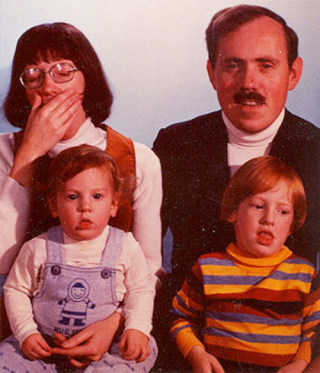
The most authentic photo JC Penny ever took
Once in a while, a little show-and-tell provides a helpful change of pace in therapy.
For example: Jane enters the room toting a huge, dusty photo album. Our time working together has been filled with stories of family, friends, co-workers, lovers, and bit players making a cameo appearance in her life. Today she brings a different glimpse into her world, a visual aid for her complex narrative. We sit together, looking at posed and candid photos of family, friends, and events from her life as she weaves together information I knew with new data that rounds out her story. I learn that her dad never smiled in photos - or anywhere else. We notice her mom seemed absent because she was always behind the camera. I can see by the look in her eyes how much she loved the boyfriend who broke her heart. She never mentioned she had a dog. Together, we share a meaningful experience with one another. She tells a few new stories, and I learn much more about the people who inhabit her life and her interactions with them.
If therapy is the talking cure and pictures are worth 1000 words, is there any surprise we’d enjoy this?
Therapy is typically heavy on words, light on visuals. Clients describe their world and therapists listen and piece together what, when, and who. We try to envision these characters and how they interact with our clients. We know that your grandma had red hair, because you told us. We know that your brother is two inches taller. We know your cherished first car was a Datsun. But I never really knew what they looked like, and how they (and you) interact in photos.

Fortunately, philemaphobia is a treatable condition
I’ve rarely asked a client to bring in pictures, but I’ve always enjoyed the sessions when they did. It’s a vulnerable act, showing a therapist pictures from your childhood or wild photos from last week’s party. Clients know this is intimate material – as genuine as they are in therapy, they know a different side of them might emerge on film when they’re among friends and family. Bringing visual records of their life into therapy is revealing and vulnerable, and I take that very seriously.
Why bring in photos? It's a revealing record of old family dynamics. It helps therapists know the characters of your life. It deepens the connection between you and your therapist. It gives an objective perspective to material you've subjectively viewed for many years. It's a shift to the typical flow of a therapy session. And it's difficult to find anyone outside your close circles who are this interested in your family albums!
A few thoughts on multimedia day:
- Quality over quantity: As tempting as it may be, this probably isn’t the time to display every photo you have. The four volume album series devoted to your visit to the world’s biggest ball of twine might not be the best use of your time. Figure that a therapy session might give time to cover 1 to 30 photos in some depth, and select accordingly.
- Prepare for photo analysis: This won’t be your typical slide show. Therapists will be interested in minute details you’d usually gloss over. How are people situated in a posed photo? What are the facial expressions? Who is missing? Do you remember how you felt when this photo was taken? This could take a while.
- How will you sit? Therapy is typically a head-on interaction, while looking at photos is usually done side-by-side. Will you share the couch? Will your therapist pull up a chair? This is a question about your comfort level – how will you feel most comfortable, and how can you communicate this with your therapist?
- Timing: This can be a powerful and meaningful session, but take a look at how this fits into the flow of therapy as a whole. If you disclosed an early trauma with a Last Minute Bomb in the last session, you should probably talk about that rather than display your photo documentary this week. Photo displays are best experienced as an enhancement of a line of thought or an intermission, not an interruption.
- What’s your medium? Will you display your masterpiece on your laptop, iPad, cell phone, photo album, or slide projector? Cell phones are nice, but not the best for a visual presentation. We all know the carousel slideshow is the best for nostalgia, but it might not be practical in a therapy office. A laptop, an iPad, or an actual photo album might be a better choice.
The DSM-5 probably has a name for this A word about ethics.

The DSM-5 probably has a name for this
A word about ethics.
There are many ways to shake things up in therapy. The meat and potatoes of therapy will always be talking about current thoughts and feelings, but an occasional shift can invigorate the work and give a new perspective. If you’re feeling like changing things up, it never hurts to talk this over with your therapist first. You can say anything, you know.
-------
I have some pictures to show you at my website and facebook page. Actually, not many pictures but a few thousand words, which is worth a couple pictures according to the exchange rate. For more riveting psychotherapy journalism like this you may want to take a look at my exposés of Kleenex, water bottles, white noise machines, the 10 minutes between sessions, and couches. We don't leave any stones unturned here at In Therapy.




